| Online: | |
| Visits: | |
| Stories: |

| Story Views | |
| Now: | |
| Last Hour: | |
| Last 24 Hours: | |
| Total: | |
Service 101: Manual Transmission Fluid (Lube) Change
Automobiles, Motorcycles and Libertarian Politics
Most people know it’s important to regularly change their car’s oil – the engine’s oil, that is. But many forget (or just don’t know) that it’s as important – for the same reasons- to periodically drain and change the “oil” inside their car or truck’s manual transmission.
I put “oil” in quotes because technically, it’s not oil – it’s gear lube (or, in some cases, automatic transmission fluid -yes, in a manual transmission; bear with a minute, I’ll explain below) but it serves the same purpose: To lubricate moving parts, to dissipate heat and to keep abrasives and contaminants away from tightly-fitted moving metal parts.
Over time, the lube (or fluid) begins to break down, or becomes suffused with contaminants. It loses its ability to lubricate and protect the gears gnashing together (at high speed) inside your transmission. You may begin to notice a degradation in shift action; it gets a little harder to change gears, for example. They fill “tighter” – especially first thing in the morning (and especially when it’s cold out). Fuel economy may dip some, too.
What’s happened is that friction has increased – and friction in the context of meshing gears is not desirable.
Regular fluid/lube changes will help keep the gears meshing as they ought to. That is, smoothly. And this, in turn, will help the transmission last longer.
You’ll want to consult the service schedule for your particular vehicle, but generally, the changeout interval is about once every 50,000 miles or five years – whichever comes first. Another side benefit of doing this is you’ll catch low gear lube/fluid levels before the box runs dry – or so low that a catastrophic failure occurs. Remember: Manual transmissions – unlike automatics – usually do not have dipsticks. The only way to check the lube/fluid level is to take out the fill plug – usually located on the side of the transmission case. If lube/fluid just barely trickles out of this hole, the box is properly filled. If it does not, you will want to add the correct type of lube/fluid until it does trickle out of the fill hole.
Speaking of which. Before you drain – or fill – anything, be absolutely certain about what you plan to put in there. Most older vehicles with manual transmissions (and many modern ones) use – as you’d expect – manual transmission gear lube, which looks (and pours) a lot like motor oil. But some manual transmissions specify automatic transmission fluid (e.g., GM Dexron III). Be sure you know what your car wants – what it needs – before you proceed.
Ok.
You will need:
A jack to raise the car.
Jack stands to support the car.
A catch pan for the old fluid (disposable aluminum turkey roasting pan works great).
A can of PB Blaster penetrant.
A breaker bar.. leverage, son.
A 1/2 drive or 3/8 drive (depending on your vehicle) extender bar. The squared-off end fits the typical fill/drain plugs perfectly.
The correct type ands quantity of gear lube or ATF.
A length (about 8 inches or so) of flexible rubber fuel line (I’ll explain in a minute).
Old clothes.
About an hour of your time.
First, get the car on flat – and solid ground. A concrete driveway or garage pad being ideal. Raise it enough to give you reasonable wiggle room underneath and then use the jack stands to support the weight of the vehicle. Do not rely on the hydraulic jack by itself. Hydraulic jacks can fail – and if you’re underneath the vehicle when that happens, you’ll be very sorry that you didn’t spend the extra five minutes to put the jack stands in place.
Now crawl under, eyeball the transmission case. You are looking for the drain plug – which is usually on the underside/bottom of the case – and the fill plug, which is usually on the side of the case. Once found, spray both of them down with the PB Blaster and let ‘em sit for about 5-10 minutes. This stuff is the aerosol equivalent of duct tape and a true friend to the home mechanic. It makes loosening and removing long-undisturbed bolts a lot easier.
Now, take the socket extender (you may need a “shortie” or a mid-sized or a longer length, depending on the wiggle room available; buy the size you need at any Sears or Northern Tools, etc.)and fit it into the recessed square hole of the fill plug.
Do not remove the drain plug first!
Learn from other’s experience, young Jedi.
Here’s the why: If you remove the drain plug, the old lube/fluid will drain out. Great, right? Yes. Unless you can’t get the fill plug out. Which happens. And then, friend, you’ve got a problem.
Always remove the fill plug first.
This will also let you check the current fluid level inside the case, which is good to know even if you’re about to do the drain and change. If it’s low, you may have a leak someplace. It’s a sign that you ought to check the level again in a month or so. Not forget about it for the next four-five years.
You will likely need a break bar (or long ratchet) for leverage as these plugs are often really tight. Apply steady, even pressure. Be sure your extender bar is fully seated in the plug and try to keep inward pressure on it as you use the breaker bar/ratchet to loosen it. Once it begins to turn, the rest will be easy.
With the fill plug out (set aside someplace, make sure not to lose it) take out the already loose (right?) drain plug and let the old fluid/lube drain completely. Go have a cup of coffee or a beer. Give it ten minutes, at least.
Now, reinstall the drain plug. I coat the threads with anti-seize compound (same stuff you use on spark plug threads) to make the next time easier. Be careful not to overtighten during the install. Remember: Most transmission cases are made of aluminum and aluminum is fairly fragile. Don’t be a meathead. A quarter to half turn more from fully seated is plenty.
Now, the last part – refilling the case.
I like to use those long slender quart barrels that gear lube typically comes in. If your car’s transmission specifies ATF, you may still want to get one of these long, slender plastic quart bottles. Why? Because you haven’t (probably) got a hydraulic gun to shoot the fresh lube/fluid into the transmission’s fill hole – the way a shop would. You will be doing it by hand, by squeezing the fluid into the hole, via the bottle.
Here’s where that length of fuel line hose comes in.
Use scissors to cut off the tip of the bottle’s screw-top nipple. Push one end of the hose onto the nipple. Now you, the bottle and the hose get under the car. Insert the other end of the hose into the fill hole on the side of the case and squeeze as much fluid as you can into the transmission. Now, carefully remove the hose from the fill hole, slide out from under, refill the bottle with fresh fluid/lube – and repeat.
Do this until you’ve filled the case to the specified level – which you’ll be able to tell you’ve done once fluid/lube begins to dribble (not gush) out of the fill hole.
Reinstall the fill plug.
You’re done!
If you value independent media, please support independent media. We depend on you to keep the wheels turning!
Our donate button is here.
If you prefer to avoid PayPal, our mailing address is:
EPautos
721 Hummingbird Lane SE
Copper Hill, VA 24079
PS: EPautos stickers are free to those who sign up for a $5 or more monthly recurring donation to support EPautos, or for a one-time donation of $10 or more. (Please be sure to tell us you want a sticker – and also, provide an address, so we know where to mail the thing!)
The post Service 101: Manual Transmission Fluid (Lube) Change appeared first on EPautos.
Source: http://ericpetersautos.com/2015/04/14/service-101-manual-transmission-fluid-lube-change/



